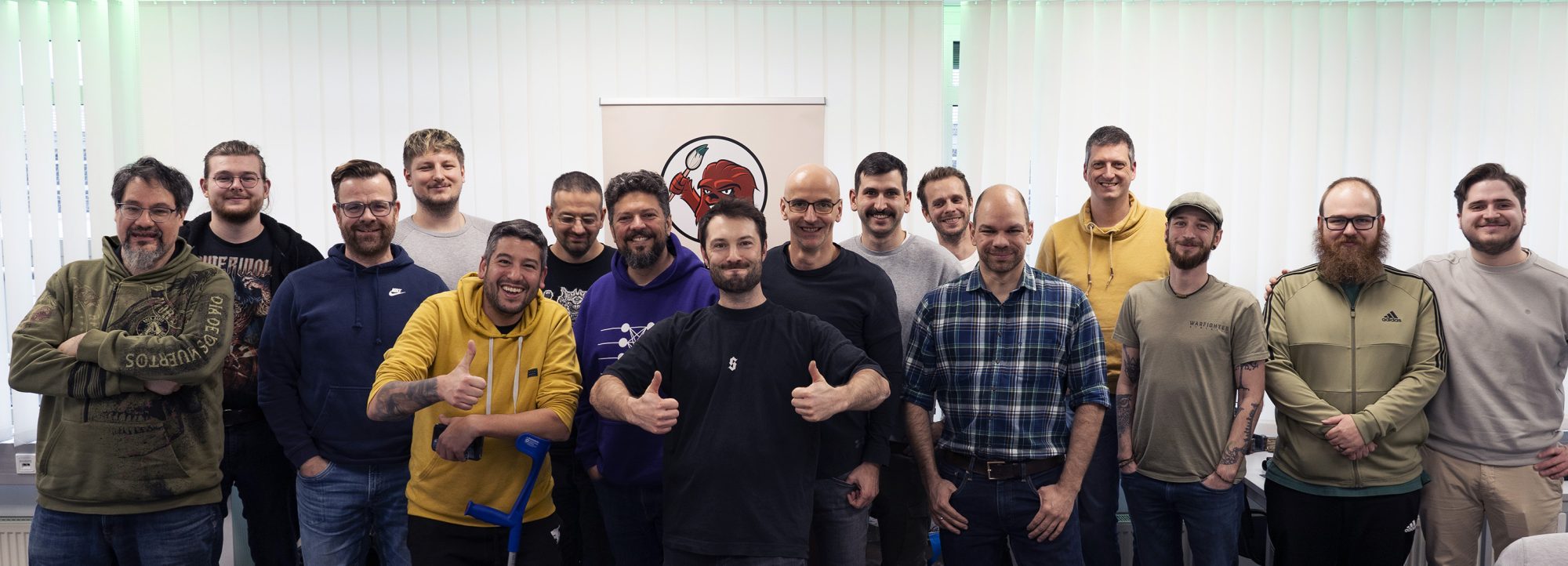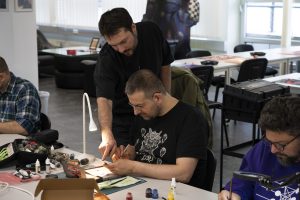I absolutely ADORE everything about painting miniatures! I’m extremely enthusiastic about it and want to help share that feeling with you.
Ich LIEBE alles am Bemalen von Figuren! Meinen Enthusiasmus möchte ich mit euch teilen und euch damit anstecken.


Hi, I’m Lukas – also known as Chewie Painting 🙂
I’m a full-time miniature artist, focusing on teaching through Patreon and commission painting. I have an insane amount of enthusiasm for this hobby and love sharing it through live workshops — helping you become a better painter while showing you how to have fun with the process. Whether you’re looking to finish your armies for the tabletop or aiming to enter painting competitions, there’s something here for you.
I live in Munich, but I love to travel and share what I’ve learned over the past 10 years of miniature painting — so I’m ready to visit your city or club! My workshops can be held in either German or English.
Hallo, ich bin Lukas, auch bekannt als Chewie Painting.
Ich lebe in München, reise aber gerne, um mein Wissen über Miniaturenbemalung, das ich in den letzten 10 Jahren gesammelt habe, mit anderen zu teilen – ich komme also gerne in eure Stadt oder euren Club!
Ich bin hauptberuflich Künstler und fokussiere mich auf das Unterrichten über Patreon sowie auf Auftragsmalerei. Ich habe unglaublich viel Begeisterung für dieses Hobby und teile diese Leidenschaft gerne in Live-Workshops. Dabei helfe ich euch, bessere Maler*innen zu werden – und vor allem dabei, Spaß am Malen zu haben. Egal ob ihr eure Armeen fürs Spielen fertigstellen oder an Malwettbewerben teilnehmen möchtet. Meine Workshops können auf Deutsch, Englisch oder einer Mischung aus beidem stattfinden.
Next Workshops:
For group workshops, I charge €100 / per participant. To book a spot, send me an email at chewie-painting@outlook.com.
Der Preis für einen Gruppenworkshop beträgt 100 € pro Teilnehmer/ in. Um einen Platz zu reservieren, schreib mir eine E-Mail ( siehe oben)
28.Dezember 2025 in Saarbrücken
Licht, Atmosphäre & OSL
Sold Out
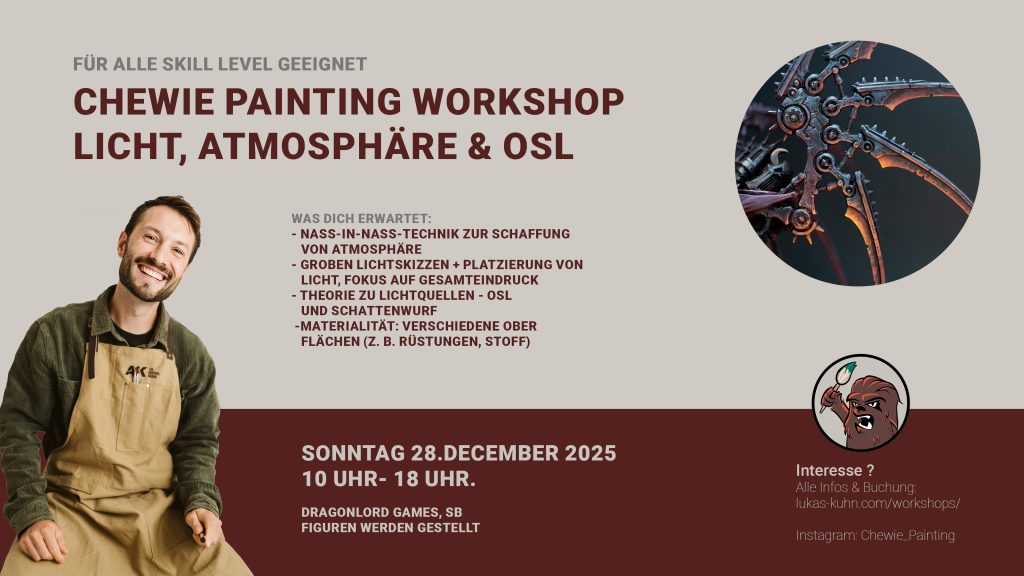
11.April 2026 im Raddadel
Grundlagen Workshop
15 Slots

Group Workshops
Feel free to contact me via Instagram (chewie_painting) if you’re interested in booking me for a 1- or 2-day workshop at your club , and we can work out the details.
Kontaktiert mich gerne über Instagram (chewie_painting), wenn ihr daran interessiert seid, mich für einen 1- oder 2-tägigen Workshop in eurem Club zu buchen, und wir können die Details besprechen.

Single Coaching
I also offer one-on-one live coaching sessions to deeply explore your personal goals and challenges together. These sessions can be tailored to your individual needs and cost €450 per day (~approx. 6 hours of painting).
Ich biete auch individuelle Einzel-Coachings an, um gemeinsam mit dir deine persönlichen Ziele anzugehen. Diese Coachings werden auf deine individuellen Bedürfnisse zugeschnitten und kosten 450 € pro Tag. (ca 6 Stunden malen)

Impressions
Patreon / PDF Guides

Here’s the link to my online tutorials as a warm-up:
Hier ist der Link zu meinen Online-Tutorials als Aufwärm Übung.
What to expect / Was euch erwartet
I like to spend most of the workshop giving you individual advice while you paint. I’ll start by demonstrating and showing a little, and then you’ll paint while I walk around and check in with each of you individually. This approach allows me to interact with you as an individual much more effectively, and differences in skill level don’t really matter.
Ich verbringe den Großteil des Workshops damit, euch während des Malens individuelle Tipps zu geben. Zu Beginn zeige und erkläre ich ein wenig, danach malt ihr, und ich gehe herum und schaue bei jedem von euch persönlich vorbei. Auf diese Weise kann ich viel besser auf euch als einzelne Personen eingehen, und Unterschiede im Können spielen dabei kaum eine Rolle.

Theory / Theorie
No matter the topic, preparation is key – so I will discuss my thoughts, my approach, and general tips. It’s important, but I also know you came for the painting, so I’ll keep this short to allow time for practice on a model.
Egal welches Thema, Vorbereitung ist entscheidend – ich werde also meine Gedanken, meinen Ansatz und allgemeine Tipps erläutern. Das ist wichtig, aber ich weiß auch, dass ihr zum Malen hier seid, deshalb halte ich es kurz, damit wir genug Zeit haben, an einer Miniatur zu üben.

You paint / Ihr malt
This is the core of the workshop: we learn by testing, experimenting, and trying things ourselves. So, the majority of the workshop will be you painting (with me as a helping hand).
Dies ist der Kern des Workshops: Wir lernen durch Testen, Experimentieren und Ausprobieren. Der Großteil des Workshops wird also darin bestehen, dass ihr malt (mit mir als helfender Hand).
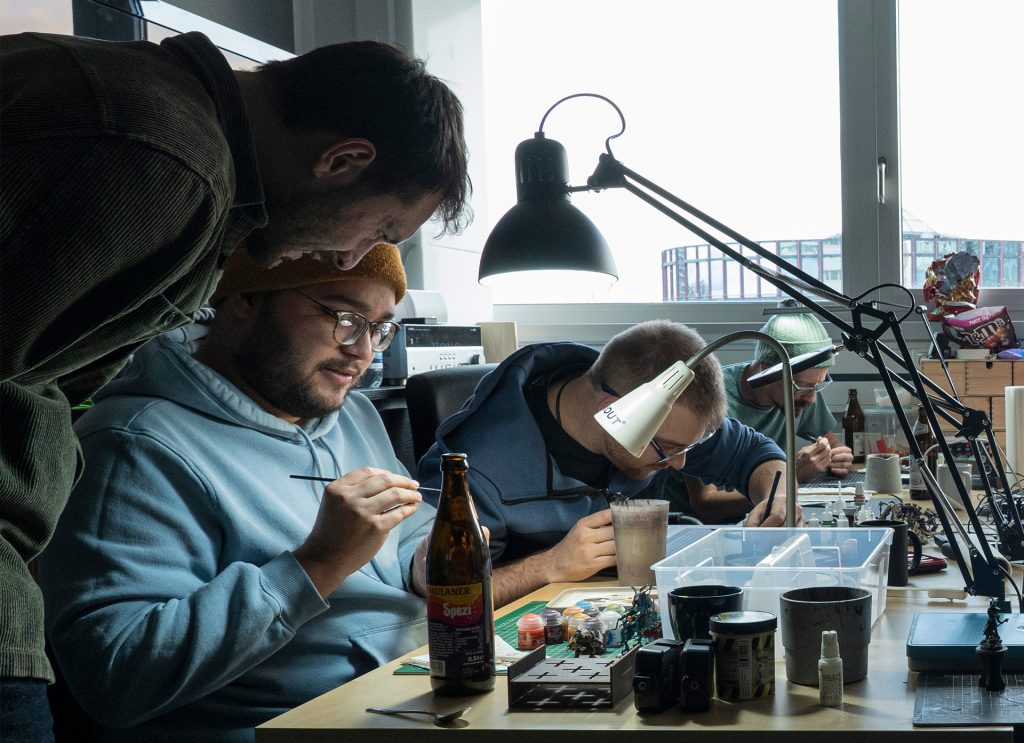
I give tips / Ich gebe Tipps
I will demonstrate myself, but it’s super important that you hold the brush in your hands. Therefore, I will go around and speak to everyone individually to assist with your personal progress.
Ich werde selbst malen und Themen an der Figur zeigen, aber es ist sehr wichtig, dass ihr den Pinsel in den Händen haltet. Deshalb werde ich herumgehen und mit jedem einzeln sprechen, um bei eurem individuellen Fortschritt zu helfen.

Topics / Themen
Topics / Themen
These are the fundamental topics I like to cover (there are more—feel free to ask anytime). I’m open to combining and mixing topics, but keep in mind that we won’t be able to cover too many in one day.
Dies sind die grundlegenden Themen, über die ich gerne spreche (es gibt noch mehr – fragt jederzeit gerne). Ich bin offen dafür, Themen zu kombinieren und zu mischen, aber beachtet bitte, dass wir an einem Tag nicht zu viele Themen abdecken können.
A) Basic techniques
Choosing the right brushes and paints. Basic techniques: basecoating, layering, drybrushing, washes. Priming: spray or brush, light vs. dark primer tones. Understanding contrast and readability on the battlefield. Some color theory & the correct use of water and a wet palette.
A) Grundkurs
Auswahl der richtigen Pinsel und Farben. Grundtechniken: Basecoating, Layering, Drybrushing, Washes. Grundierung: Spray oder Pinsel, helle vs. dunkle Grundierung. Verständnis von Kontrast und Lesbarkeit auf dem Spielfeld. Etwas Farbtheorie & der richtige Einsatz von Wasser und Nasspalette.
B) Speedpainting Armies
Working in batches: Efficient batch-painting workflow. Focusing on key details for a quick tabletop look.
Choosing a coherent army color scheme that stands out. Color selection that matches the base and the army’s story. Using tools like airbrush, oil paints, and drybrushing with speedpaints for greater efficiency.
B) Effizientes Armee-Malen
Arbeiten in Serien: Effizienter Batch-Painting-Workflow. Fokussierung auf Schlüsseldetails für einen schnellen Tabletop-Look.
Auswahl eines kohärenten Farbschemas für die Armee, das auffällt. Farbauswahl, die zur Base und der Story der Armee passt. Einsatz von Tools wie Airbrush, Ölfarben und Trockenbürsten mit Speedpaints für mehr Effizienz.
C) OSL (Object Source Lighting)
Theory of light sources and shadow casting. Placement and color selection for light sources. Working with airbrush or brush for smooth transitions. Application on various surfaces such as armor or fabric. Tips for not overdoing OSL effects. Cast shadows will also be covered if you’re interested.
C) Lichteffekte
Theorie zu Lichtquellen und Schattenwurf. Platzierung und Farbwahl für Lichtquellen. Arbeiten mit Airbrush oder Pinsel für weiche Übergänge. Anwendung auf verschiedene Oberflächen wie Rüstungen oder Stoff. Tipps, um OSL-Effekte nicht zu übertreiben. Schlagschatten werden ebenfalls behandelt, wenn du interessiert bist.
D) Metallics
(non and true Metalics)
Simulating light reflections and creating color gradients. Base colors for gold, steel, and other metals. Highlighting edges and reflections. The difference between matte and shiny metal looks. Comparison of NMM vs. True Metallics.
D) Metall bemalen
Lichtreflexionen simulieren und Farbverläufe erzeugen. Grundfarben für Gold, Stahl und andere Metalle. Hervorheben von Kanten und Spiegelungen. Unterschied zwischen mattem und glänzendem Metall-Look. Vergleich NMM vs. True Metallics
E) Basing / Dioramas & Composition
Selection of low-cost basing materials: cork, sand, stones, twigs. Use of texture pastes, grass tufts, and plants. Adding storytelling elements (e.g., debris, skulls). Realistic depiction of snow, water, or lava. Tips for color harmony between the base and the miniature.
Learn how to manage proportions and compositions for dioramas, small scenes, or even just a single miniature and its base.
F) Weathering & Vehicles
Use pigments to create dust, rust, and earth effects. Apply chipping techniques to simulate peeling paint. Use oil paints to build gradients and depth. Add dirt, blood, and battle damage. Make your minis look “used”—especially effective on vehicle models.
E) Bases / Dioramen & Komposition
Auswahl von günstigen Basenmaterialien: Kork, Sand, Steine, Äste. Verwendung von Strukturpasten, Grasbüscheln und Pflanzen. Hinzufügen von Storytelling-Elementen (z. B. Trümmern, Schädeln). Realistische Darstellung von Schnee, Wasser oder Lava. Tipps für Farbharmonien zwischen Base und Miniatur.
Lerne, wie man Proportionen und Kompositionen für Dioramen, kleine Szenen oder sogar nur eine einzelne Miniatur mit ihrem Sockel gestaltet.
F) Alterungseffekte & Fahrzeuge
Verwende Pigmente, um Staub-, Rost- und Erdeffekte darzustellen. Nutze Abplatztechniken, um abgeplatzte Farbe zu simulieren. Mit Ölfarben lassen sich sanfte Übergänge und Tiefe erzeugen. Ergänze Schmutz, Blut und Kampfschäden. Lass deine Minis „gebraucht“ aussehen – besonders wirkungsvoll bei Fahrzeugmodellen.
G) Atmosphere Painting
I like to teach how to create atmosphere using wet blending—starting with a quick sketch and gradually building up the details. We’ll explore light placement and focus on strong storytelling throughout the process. Cast shadows can also be part of this.
This approach is perfect for painters looking to develop their own style and break away from the usual formula of “face color 1, body color 2,” and so on. It’s a more artistic and intuitive method.
G) Atmosphäre malen
Ich zeige gerne, wie man mit Nass-in-Nass-Technik Atmosphäre schafft – von schnellen, groben Pinselstrichen als Lichtskizze bis hin zu feinen Details. Wir schauen uns gezielt die Platzierung von Licht an und legen großen Wert auf den Gesamteindruck und die Wirkung der Figur. Auch gemalte Schlagschatten können wir uns anschauen.
Dieser Kurs ist ideal für alle, die ihren eigenen Stil finden und sich von der üblichen Herangehensweise à la „Gesicht: Farbe 1, Körper: Farbe 2“ lösen möchten. Es geht vielmehr um einen künstlerischen, intuitiven Ansatz.
Orga
The cost is 100 € per participant per day. Please organize internally to determine who can attend and which date works best, so that we reach at least 7 participants (maximum 15). You are well-connected among yourselves and know each other better.I think it’s much more sensible if one person travels a long distance, rather than 10 people having to come to Munich (let’s share the travel costs, and then I’m available for you throughout Germany).
Die Kosten belaufen sich auf 100 € pro Teilnehmer und Tag. Bitte organisiert intern selbstständig, wer teilnehmen kann und welches Datum euch am besten passt, damit wir mindestens 7 Teilnehmer erreichen (maximal 15). Ihr seid untereinander gut vernetzt und kennt euch besser. Ich finde, es ist viel sinnvoller, wenn eine Person weit reist, anstatt dass 10 Leute nach München fahren müssen (lasst uns die Fahrtkosten teilen, dann bin ich für euch in ganz Deutschland verfügbar)

What to bring / Was ihr bitte mitbringt

Curiosity / Neugier
It may sound trivial, but I wanted to mention it anyway! Think about what you want to learn, what questions you have, and what never seems to work. I’m sure you’ll leave the day with renewed energy for your projects.
Es klingt vielleicht banal, aber ich wollte es trotzdem erwähnen! Überlegt euch, was ihr lernen möchtet, welche Fragen ihr habt und was nie so richtig klappen will. Ich bin mir sicher, dass ihr mit neuer Energie für eure Projekte aus dem Tag gehen werdet.

2-3 Minis
Bring any finished miniatures you’ve painted so I can assess your level and also provide some feedback.
Bringt bitte fertige Figuren mit, die ihr bemalt habt, damit ich euer Level einschätzen und euch auch ein wenig Feedback geben kann.

Tools & Colours
Brushes (small fine ones, all-rounders, bristle brushes, drybrushes), Wet palette (I have 2-3 extras, but not enough for everyone) Paints (your favorite colors, around 10-20 different ones should be enough)
Pinsel (kleine feine, Allrounder, Borstenpinsel, Trockenbürster), Nasspalette (ich habe 2-3 extra, aber nicht für alle), Farben (eure Lieblingsfarben, ca. 10-20 verschiedene reichen aus, ich bringe selbst ein Sortiment mit und verteile Farben)
Here are the essentials, plus an example of colors from AK that I usually bring:

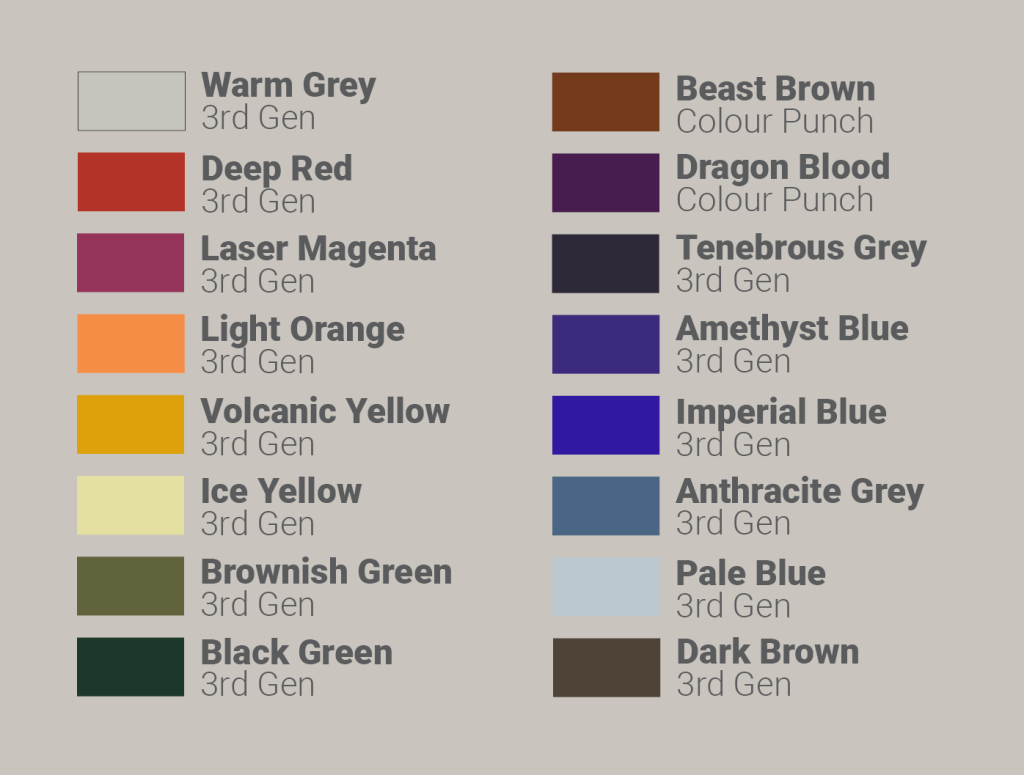
you can contact me via instagram or email: Chewie-Painting@outlook.com

“Lukas war super geduldig und sympathisch! jeder Zeit wieder”
Roli- Berlin


“Super inspired after this workshop to paint more”
Fernandez – Munich


“Absolute fantastic human and great teacher- i learned a lot and got the feeling I improved even after just one day”
Felix – Munich

